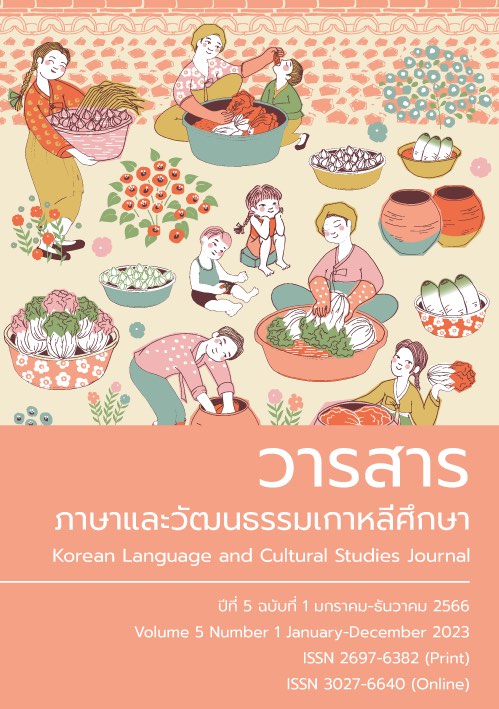Republic of Korea’s Digital Media Participatory Cultural Public Diplomacy Policy
Main Article Content
Abstract
This study mainly investigates the role of the Korean government in promoting participatory public diplomacy policies. According to recent research, Korean government agencies have implemented specific public diplomacy policies to promote K-content by enabling the public to participate. Major agencies of the Korean government that pursue a ‘citizen diplomacy’ policy through a foreign-participatory cultural public diplomacy policy using digital media include the Ministry of Foreign Affairs and the Ministry of Culture, Sports and Tourism. As a result of analyzing research results based on The Three Layers of Public Diplomacy framework, according to Cowan and Arsenault (2008), Korea's public diplomacy is characterized by a collaboration layer, which is evaluated as the most effective method. Because it is a bilateral communication, it means that people from different cultures are connected through mutual exchange, focusing on relationships with foreigners. Therefore, various activities under Korea's inclusive public diplomacy policy are expected to play an important role in developing and spreading Korean culture through public-private cooperation.
Article Details
References
กิตติ ประเสริฐสุข. (2561). Soft Power ของเกาหลีใต้: จุดแข็งและข้อจำกัด. International Journal of East Asian Studies, 22(1), 122-139.
กฤตพร แซ่อึ๊ง. (2562). นโยบาย Soft power กับการส่งออกวัฒนธรรมของเกาหลีใต้ ค.ศ. 1997-ปัจจุบัน. บทความวิจัยปริญญาอักษรศาสตรบัณฑิต, คณะอักษรศาสตร์, มหาวิทยาลัยศิลปากร.
ทรงพล สุ่นตระกูล. (2561). อิทธิพลของสื่อดิจิทัลทางการตลาดเพื่อการรับรู้คุณค่าความเป็นสถาบันการศึกษาและการเปลี่ยนแปลงทัศนคติที่ส่งผลต่อการตัดสินใจเข้าศึกษาระดับบัณฑิตศึกษาที่มหาวิทยาลัยเอกชน. วิทยานิพนธ์บริหารธุรกิจมหาบัณฑิต, บัณฑิตวิทยาลัย, มหาวิทยาลัยกรุงเทพ.
ประณาลี เหมเวช. (2560). อิทธิพลของรูปแบบการนำเสนอเนื้อหา การสื่อสารแบบปากต่อปากทางอิเล็กทรอนิกส์ และความไว้วางใจ ที่ส่งผลต่อความตั้งใจมีส่วนร่วมของผู้ใช้โซเชียลมีเดียยูทูบ ในช่องส่วนตัวของยูทูบเบอร์. การค้นคว้าอิสระบริหารธุรกิจมหาบัณฑิต, บัณฑิตวิทยาลัย, มหาวิทยาลัยกรุงเทพ.
วริศรา ภาคมาลี. (2563). การทูตสาธารณะ เครื่องมือ Soft Power ของเกาหลีใต้ กรณีศึกษา การทูตวัฒนธรรม. การค้นคว้าอิสระรัฐศาสตรมหาบัณฑิต สาขาวิชาการเมืองการปกครอง สำหรับนักบริหาร, คณะรัฐศาสตร์, มหาวิทยาลัยธรรมศาสตร์.
สุภาพิชญ์ ถิระวัฒน์. (2565). Soft Power (อำนาจละมุน) [บทวิทยุรายการ ร้อยเรื่อง...เมืองไทย]. กรุงเทพฯ: สถานีวิทยุกระจายเสียงรัฐสภาและสำนักวิชาการ, สำนักงานเลขาธิการสภาผู้แทนราษฎร
เสกสรร อานันทศิริเกียรติ. (2563). ยุทธศาสตร์การทูตสาธารณะของญี่ปุ่นและเกาหลีใต้: บทเรียนและข้อเสนอแนะต่อไทย. กรุงเทพฯ: ศูนย์ศึกษาการต่างประเทศ กระทรวงการต่างประเทศ.
อาโป เอกอนันต์กูล. (2561). พัฒนาการของกระแส K-WAVE : กรณีศึกษาละครชุดเกาหลีในไทย (ค.ศ. 2000-ปัจจุบัน). บทความวิจัยปริญญาอักษรศาสตรบัณฑิต, คณะอักษรศาสตร์, มหาวิทยาลัยศิลปากร, นครปฐม.
Bjola, C., & Jiang, L. (2015). Social Media and Public Diplomacy: A Comparative Analysis of the Digital Diplomatic Strategies of the EU, Us and Japan in China. In C. Bjola & M. Holmes (Eds.), Digital Diplomacy: Theory and Practice (pp. 71-88). Abingdon: Routledge.
Cowan, G., & Arsenault, A. (2008). Moving from Monologue to Dialogue to Collaboration: The Three Layers of Public Diplomacy. The ANNALS of the American Academy of Political and Social Science, 616(1), 10-30.
Fayer, H. (2008). Quick Read Synopsis: Public Diplomacy in a Changing World. The ANNALS of the American Academy of Political and Social Science, 616(1), 291-317. doi:10.1177/0002716208314503
Kim, E., & Lee, J. (2021). Record 3,432 Honorary Reporters from 105 countries
named. Retrieved August 1, 2022, from https://www.kocis.go.kr/eng/ openNews/view.do?seq=1037978&rn=&page=3&pageSize=10&photoPageSize=6&totalCount=0&searchType=&searchText=
Kim, H., Kim, S., Majid, S. M. H., Kim, G., & Lee, J. (2022). 2021 Survey on Mutual Perceptions of ASEAN and Korean Youths. Seoul: ASEAN-Korea Centre.
Mauleon, S. M. C., & Dalizon, A. C. P. (2021). Ready, Set, Action: The Role of Digital Media Tools in Harnessing Youth Power for Greater Cultural Understanding. Retrieved August 1, 2022, from https://www.as eankorea.org/aseanZone/download File2.asp?boa_filenum=5320 Ministry of Culture, Sports, and Tourism and Korean Culture and Information
Service. (n.d.). About HR. Retrieved August 1, 2022, from https://hono raryreporters.korea.net/about.do?tpln=1
Ministry of Foreign Affairs, Republic of Korea. (n.d.). Introduction of the Public
Diplomacy. Retrieved August 1, 2022, from https://www.mofa.go.kr /eng/wpge/m_22841/contents.do
Mission of the Republic of Korea to ASEAN. (n.d.). About Mission. Retrieved August 1, 2022, from https://overseas.mofa.go.kr/asean-en/wpge/m_2557/contents.do
Pamment, J. (2016). Digital diplomacy as transmedia engagement: Aligning theories of participatory culture with international advocacy campaigns. New Media & Society, 18(9), 2046-2062.
Park, H., & Yoon, H. (2022). Record-high 4834 from 122 nations join Honorary
Reporters this year. Retrieved August 1, 2022, from https://www.ko rea.net/NewsFocus/Culture/view?articleId=214645
Saliu, H. (2020). The Evolution of the Concept of Public Diplomacy from the Perspective of Communication Stakeholders. Medijska istraživanja, 26(1), 69-86. doi:10.22572/mi.26.1.4
UNESCO. (2022). Cutting Edge | From standing out to reaching out: cultural
diplomacy for sustainable development. Retrieved November 19,
_R0=080713870fab20007634859ffc1d0724e0480c6e80fe115f3c17fc2ccd85fce4afcd657b019463fe08f88ca5b5143000a84384bd31b412742321c935aac8aad3617f59868e1e7161ce2fbb032149606ee1b228dc0039102b6cd9191b98dcef91
Yim, H. (2002). Cultural identity and cultural policy in South Korea. International journal of cultural policy, 8(1), 37-48.
신남방 정책(삭제)주아세안 대한민국 대표부. (n.d.). Retrieved November 19, 2023, from https://overseas.mofa.go.kr/asean-ko/wpge/m_21538/contents.do


